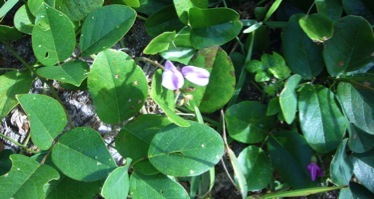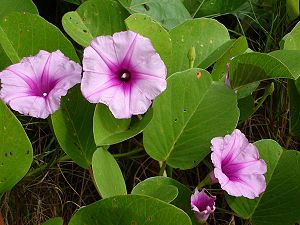Canavalia maritima, Rosea, Beach Bean
It’s the tank of beans: Three inches long, an inch wide and very thick. And with good reason, it lives near the sea.
Canavalia maritima (aka rosea) gets mixed reviews, eaten for a long time and listed as toxic. The adult beans are definitely to be avoided but the young seeds are being eaten by humans somewhere now. Here is what Prof. Daniel Austin has to say about it in his huge book “Florida Ethnobotany:”
“Ignorance, they say, is bliss. So, my students and I were certainly blissful for years. At one time I had an anthropology student who was interested in plants used by people. She convinced me that the seeds of the bay bean [Canavalia maritima] were edible by gathering a handful in the field, cracking the seed coats with her teeth, and eating the contents. I tried them, and they were tasty — nutty and sweet. Then, I read about the alkaloids and proteins found in the seeds, and discovered that they were considered by many to be toxic. I quit eating them and stopped showing students how to eat them.
“However, there is a long history of people eating many of the species in the Canavalia. For example C. ensiformis is grown as a vegetable in tropical areas. The young pods are sliced and eaten like French Beans… C. gladiata seeds are edible, and its foliage is used for fodder.
“More recent studies of chemicals have established that… Canavalia contains cyanides, complex proteins, and alkaloids. … Yet other studies have confirmed what humans discovered thousands of years ago — processing the seeds renders them edible….”
Austin goes on to say there is no record of local natives using the C. Maritima for food, and among Caribbean people it is viewed as a medicine.
Perhaps C. maritima should be put in the same category as its close look alike, the Ipomoea pes-caprae, edible in small amounts in an emergency. When the two plants are in blossom it is easy to tell them apart. C. maritima has a pea blossom (wings and keel) I. pes-caprae, a morning glory blossom, fused petals. When not in blossom the C. maritima has alternating leaves of three, whereas the I. pes-caprae has single alternating leaves. Mature C. maritima beans are toxic, which is just as well. I have found the pods while out canoeing or kayaking and they are tough to open.
Canavalia (kan-uh-VAY-lee-uh) is the latinized version of the native Malabar name for the plant. Maritima (mar-ih-TEE-muh) of or near the ocean.
Green Deane’s “Itemized” Plant Profile
IDENTIFICATION: Vine to 30 feet or more, creeping along the sand. Leaves alternating with three thick leaflets to five inches long, oval to oblong, blunt at tip. Bean-shaped flower. Fruit a dry pod to six inches long, an inch or less wide, flattened.
TIME OF YEAR: Summer and fall
ENVIRONMENT: Beaches above the high-tide line.
METHOD OF PREPARATION: Young seeds boiled throughly.



